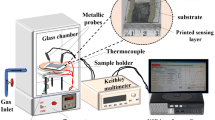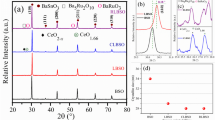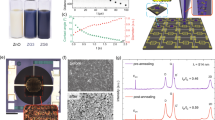Abstract
It is beneficial to develop the cost-effective, ultra-sensitive ZnO-based sensor for the rapid detection and quantification of the ammonia and formaldehyde breath markers under ambient conditions. Here, one-step solution route was adopted to formulate the aqueous combustible molecular precursor-based clogging free screen-printing ink consisting of zinc nitrate as an oxidizer, glycine as fuel, and eco-friendly binder sodium carboxymethylcellulose. The formulated precursor was deposited on the glass substrates via a screen-printing technique followed by annealing at different temperatures for an hour. Screen printed ZnO sensors processed at 500 °C with high crystallinity, less lattice distortion, low optical bandgap, and high concentration of donor defects showed remarkably high NH3 gas response ~ 336 and a moderate HCHO response ~ 16.4 towards the 5 ppm and 10 ppm of the respective gases. In addition it's LOD values is drawn as 0.6 ppm and 2.9 ppm for NH3 and HCHO gases, respectively, and exhibits superior selectivity towards ammonia. Faster diffusion of oxygen vacancies (Vo) in the smaller crystallites resulted expeditious sensor kinetics in the screen-printed sensor processed at 400 °C. Response and recovery time were recorded to be 50 s and 50 s to the 5 ppm of NH3, respectively. The crystallinity-dominant domain overcomes the adverse effect of larger grains on the gas response of screen-printed ZnO sensor processed at 500 °C. Robust, scalable, and cost-effective screen-printed ZnO conductometric sensors demonstrated here has a potential application in clinical diagnosis, and also in monitoring the NH3 and HCHO gases at low ppm-level.









Similar content being viewed by others
References
M. Righettoni et al., Breath analysis by nanostructured metal oxides as chemo-resistive gas sensors. Mater. Today. 18(3), 163–171 (2015)
S. Davies et al., Quantitative analysis of ammonia on the breath of patients in end-stage renal failure. Kidney Int. 52(1), 223–228 (1997)
V.A. Luyckx et al., The global burden of kidney disease and the sustainable development goals. Bull World Health Organ. 96(6), 414 (2018)
C. Turner et al., A longitudinal study of ammonia, acetone and propanol in the exhaled breath of 30 subjects using selected ion flow tube mass spectrometry SIFT-MS. Physiol. Meas. 27(4), 321 (2006)
H. Li et al., Flexible room-temperature NH3 sensor for ultrasensitive, selective, and humidity-independent gas detection. ACS Appl. Mater. Interfaces 10(33), 27858–27867 (2018)
P. Fuchs et al., Breath gas aldehydes as biomarkers of lung cancer. Int. J. Cancer. 126(11), 2663–2670 (2010)
C. Gu et al., Synthesis of the porous NiO/SnO2 microspheres and microcubes and their enhanced formaldehyde gas sensing performance. Sens. Actuators B 241, 298–307 (2017)
S. Wang et al., Constructing chinky zinc oxide hierarchical hexahedrons for highly sensitive formaldehyde gas detection. J. Alloys Compd. 775, 402–410 (2019)
K. Zhou et al., On-line monitoring of formaldehyde in air by cataluminescence-based gas sensor. Sens. Actuators B 119(2), 392–397 (2006)
From conventional films to nanostructured materials, I. ZCastro-Hurtado et al., Conductometric formaldehyde gas sensors. A review. Thin Solid Films 548, 665–676 (2013)
G. Korotcenkov, The role of morphology and crystallographic structure of metal oxides in response of conductometric-type gas sensors. Reports. Mater. Sci. 61(1–16), 1–39 (2008)
A. Katoch et al., Competitive influence of grain size and crystallinity on gas sensing performances of ZnO nanofibers. Sens. Actuators B 185, 411–416 (2013)
Y. Chen et al., Reduced-temperature ethanol sensing characteristics of flower-like ZnO nanorods synthesized by a sonochemical method. Nanotechnology 17(18), 4537 (2006)
C. Xu et al., Grain size effects on gas sensitivity of porous SnO2-based elements. Sens. Actuators B 3(2), 147–155 (1991)
P. Sahay, R. Nath, Al-doped ZnO thin films as methanol sensors. Sens. Actuators B 134(2), 654–659 (2008)
L. Zhu, W. Zeng, Room-temperature gas sensing of ZnO-based gas sensor: A review. Sens. Actuator A 267, 242–261 (2017)
G. Eranna et al., Oxide materials for development of integrated gas sensors—a comprehensive review. Crit. Rev. Solid State Mater. Sci. 29(3–4), 111–118 (2004)
J. Cui et al., UV-light illumination room temperature HCHO gas-sensing mechanism of ZnO with different nanostructures. Sens. Actuators B 227, 220–226 (2016)
G.K. Mani, J.B.B. Rayappan, Selective detection of ammonia using spray pyrolysis deposited pure and nickel doped ZnO thin films. Appl. Surf. Sci. 311, 405–412 (2014)
A. Moustaghfir et al., Structural and optical studies of ZnO thin films deposited by rf magnetron sputtering: influence of annealing. Surf. Coat. Technol. 174, 193–196 (2003)
G. Manjunath et al., A scalable screen-printed high performance ZnO-UV and gas sensor: effect of solution combustion. Mater. Sci. Semicond. Process. 107, 104828 (2020)
S.-W. Choi et al., Dependence of gas sensing properties in ZnO nanofibers on size and crystallinity of nanograins. J. Mater. Res. 26(14), 1662–1665 (2011)
T. Senthil, S. Anandhan, Structure–property relationship of sol–gel electrospun ZnO nanofibers developed for ammonia gas sensing. J. Colloid Interface Sci. 432, 285–296 (2014)
J.-J. Zhang et al., Effect of annealing treatment on morphologies and gas sensing properties of ZnO nanorods. Trans. Nonferrous Met. Soc. 24(3), 736–742 (2014)
H. Waqas et al., Unique morphologies of zinc oxide synthesized by thermal decomposition and co-precipitation routes: Ultraviolet absorption and luminescence characteristics. Cryst Res Tech. 50(5), 379–388 (2015)
G. Manjunath et al., A comparative study on enhancer and inhibitor of glycine–nitrate combustion ZnO screen-printed sensor: detection of low concentration ammonia at room temperature. J. Mater. Sci. Mater. Electron. 31, 10366–10380 (2020)
R. Xing et al., Superparamagnetic magnetite nanocrystal clusters as potential magnetic carriers for the delivery of platinum anticancer drugs. J. Mater. Chem. 21(30), 11142–11149 (2011)
V. Pushpamalar et al., Optimization of reaction conditions for preparing carboxymethyl cellulose from sago waste. Carbohydr. Polym. 64(2), 312–318 (2006)
R.A. Kumar et al., Crystal growth, optical and thermal studies of nonlinear optical γ-glycine single crystal grown from lithium nitrate. Optik. 123(5), 409–413 (2012)
G.S. Machado et al., Immobilization of anionic metalloporphyrins on zinc hydroxide nitrate and study of an unusual catalytic activity. J. Catal. 274(2), 130–141 (2010)
M. Ahmad et al., Preparation of highly efficient Al-doped ZnO photocatalyst by combustion synthesis. Curr. Appl. Phys. 13(4), 697–704 (2013)
D. Nath et al., X-ray diffraction analysis by Williamson-Hall, Halder-Wagner and size-strain plot methods of CdSe nanoparticles-a comparative study. Mater. Chem. Phys. 239, 122021 (2020)
G. Manjunath et al., Effect of O2, N2 and H2 on annealing of pad printed high conductive Ag–Cu nano-alloy electrodes. Mater. Res. Express. 5(1), 014014 (2018)
Z. Fang et al., Influence of post-annealing treatment on the structure properties of ZnO films. Appl. Surf. Sci. 241(3–4), 303–308 (2005)
B.P. Choudhury et al., Annealing temperature and oxygen-vacancy-dependent variation of lattice strain, band gap and luminescence properties of CeO2 nanoparticles. J. Exp. Nanosci. 10(2), 103–114 (2015)
G. Korotcenkov et al., Thin film SnO2-based gas sensors: film thickness influence. Sens. Actuators B Chem 142(1), 321–330 (2009)
S. Studenikin et al., Optical and electrical properties of undoped ZnO films grown by spray pyrolysis of zinc nitrate solution. J. Appl. Phys. 83(4), 2104–2111 (1998)
M.R. Parra, F.Z. Haque, Aqueous chemical route synthesis and the effect of calcination temperature on the structural and optical properties of ZnO nanoparticles. J. Mater. Res. Technol. 3(4), 363–369 (2014)
S. Bayan, D. Mohanta, Fragmentation of elongated-shaped ZnO nanostructures into spherical particles by swift ion impact. Physica E Low Dimens. Syst. Nanostruct. 54, 288–294 (2013)
S. Bayan, P. Chakraborty, Secondary ion mass spectrometry and photoluminescence study on microstructural characteristics of chemically synthesized ZnO nanowalls. Appl. Surf. Sci. 303, 233–240 (2014)
L. Yu et al., Both oxygen vacancies defects and porosity facilitated NO2 gas sensing response in 2D ZnO nanowalls at room temperature. J. Alloys Compd. 682, 352–356 (2016)
L. Shi et al., High-performance formaldehyde gas-sensors based on three dimensional center-hollow ZnO. Phys. Chem. Chem. Phys. 17(46), 31316–31323 (2015)
S. David et al., A highly sensitive, selective and room temperature operatable formaldehyde gas sensor using chemiresistive g-C3N4/ZnO. Mater. Adv. 1(8), 2781–2788 (2020)
N. Izu et al., The effects of the particle size and crystallite size on the response time for resistive oxygen gas sensor using cerium oxide thick film. Sens. Actuators B 94(2), 222–227 (2003)
A.J. Kulandaisamy et al., Room temperature ammonia sensing properties of ZnO thin films grown by spray pyrolysis: Effect of Mg doping. J. Alloys Compd. 688, 422–429 (2016)
D. Ponnusamy, S. Madanagurusamy, Nanostructured ZnO films for room temperature ammonia sensing. J. Electron. Mater. 43(9), 3211–3216 (2014)
U. Patil et al., Room temperature ammonia sensor based on copper nanoparticle intercalated polyaniline nanocomposite thin films. Appl. Surf. Sci. 339, 69–74 (2015)
D. Zhang, C. Jiang, Room-temperature high-performance ammonia gas sensor based on layer-by-layer self-assembled molybdenum disulfide/zinc oxide nanocomposite film. J. Alloys Compd. 698, 476–483 (2017)
J. Zhang et al., Polypyrrole-coated SnO2 hollow spheres and their application for ammonia sensor. J. Phys. Chem. C. 113(5), 1662–1665 (2009)
D. Zhang et al., Fabrication of polypyrrole/Zn2SnO4 nanofilm for ultra-highly sensitive ammonia sensing application. Sens. Actuators B 274, 575–586 (2018)
P.-G. Su, L.-Y. Yang, NH3 gas sensor based on Pd/SnO2/RGO ternary composite operated at room-temperature. Sens. Actuators B 223, 202–208 (2016)
T. Wang et al., Studies on NH3 gas sensing by zinc oxide nanowire-reduced graphene oxide nanocomposites. Sens. Actuators B 252, 284–294 (2017)
S. Li et al., The room temperature gas sensor based on Polyaniline@ flower-like WO3 nanocomposites and flexible PET substrate for NH3 detection. Sens. Actuastors B 259, 505–513 (2018)
G.K. Mani, J.B.B. Rayappan, A highly selective room temperature ammonia sensor using spray deposited zinc oxide thin film. Sens. Actuators B 183, 459–466 (2013)
Acknowledgements
Financial support from Science and Engineering Research Board (SERB), Department of Science and Technology, India (ECR/2015/000339) is gratefully acknowledged. One of the author P. Nagaraju would like to thank DST-SERB for financial support to carry out the present work (ECR/2016/000534).
Author information
Authors and Affiliations
Corresponding author
Ethics declarations
Conflict of interest
The Author(s) declare(s) that there is no conflict of interest.
Additional information
Publisher's Note
Springer Nature remains neutral with regard to jurisdictional claims in published maps and institutional affiliations.
Supplementary Information
Below is the link to the electronic supplementary material.
Rights and permissions
About this article
Cite this article
Manjunath, G., Nagaraju, P. & Mandal, S. Ultra-sensitive clogging free combustible molecular precursor-based screen-printed ZnO sensors: a detection of ammonia and formaldehyde breath markers. J Mater Sci: Mater Electron 32, 5713–5728 (2021). https://doi.org/10.1007/s10854-021-05292-z
Received:
Accepted:
Published:
Issue Date:
DOI: https://doi.org/10.1007/s10854-021-05292-z




